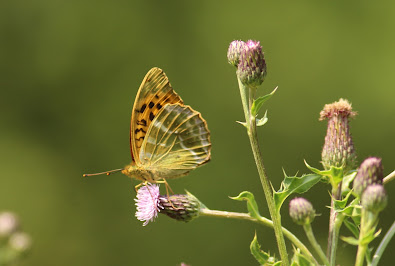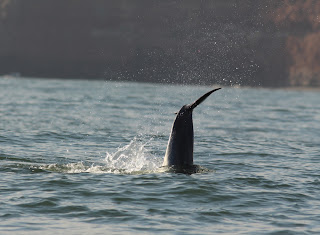The Black-browed Albatross showed on and off all morning, whilst I sat forlornly at my desk. I turned my phone off and focussed my attention on work, vowing to head to the coast after tea. The bird flew north at midday and there were no further reports by the time I put my phone back on after work. Not to be deterred, we would still go, we couldn't not.
We headed east. I had a feeling of dread and creeping anxiety and nearly u-turned before we'd escaped the village, but I realised that an evening at Bempton Cliffs in the height of the breeding season was eminently better than sitting at home, fretting over what could have been. After an uneventful drive, we arrived at Bempton Cliffs car park without any news on the bird, which by now, had been missing for several hours.
As we got our gear ready, a nearby bloke was chatting to a couple who said they'd seen some guy running because somebody had claimed they'd seen it. I asked when this was - 'ten minutes ago' was the surprising reply. We left nothing but dust in the car park.
Heading down to New Rollup, we were soon watching the albatross on the sea. Relief! She* was back. Still distant, but without heat haze and with warm evening light, the views were reasonable. We squinted through scopes as the bird gradually drifted east with a few comparatively tiny Fulmars for company. I willed the bird to come in to the cliffs. An hour passed, the bird preened, did an occasional wing stretch, but generally just loafed and drifted with the tide. Was I going to leave frustrated for a third time?
*I have no real idea whether this bird is a male or female, but I will go with the latter.
Without warning, the albatross suddenly pattered across the water and took flight. Panic! Philip who had been letting an old lady have a look through his scope struggled for a minute to get back on the bird, but shortly did so as people called out directions. The bird, like a WW2 bomber, gently gained height and headed straight towards us, on impossibly long wings. It was finally going to happen! She was coming in, gradually closing the distance between us. I was locked on to her; nothing else mattered and time stood still. Her features became apparent; that stylish black eye-brow, the long, orange-tipped yellow beak, the ash-grey tail and pale primary streaks on otherwise black wings. Everything else in the world was just noise at that moment; I felt like the only person witnessing this monumental event.



She approached the mighty edifice of Staple Newk, and cruised round on dead straight black wings, a giant cruciform dwarfing the throngs of Gannets. After a number of circuits, she rose in altitude and then came directly towards us half way up the cliffs, passing within a few metres below. We piled over to other side of the platform and saw her u-turn, heading back towards Staple. She arced round, among the blizzard of Razorbills and Kittiwakes, an aerial queen among her minions.
After a while, it was clear she was keen to land on the slope above the arch where a lot of young Gannets were hanging out. Huge grey feet on surprisingly long legs were lowered as she made her approach.
Several times she tried before succeeding, disappearing onto a shelf, obscured by part of the cliff. It was obvious where she was, as the surrounding Gannets all stood and stared at her, in wonder. Once or twice, a pair of huge black wings, with white linings, rose up above the rocks as she stretched. Would that be the end of her breathtaking performance? After 15 minutes, she unexpectedly waddled out into the open, and proceeded to do a little head-tossing display, tidied up a patch of cliff and then settled down.
Tricky to pick out from a distance! Below: I love the way the Gannets sit round her in awe! We watched her, beaming like Yorkshire cats until the dusk turned the blue sea purple and the Gannets began to hunker down for the night.
What a majestic and awe-inspiring bird. She was worth every minute of the four year wait, every anxious drive to the coast and every despairing dip. I have been lucky enough to have seen plenty of rare birds in this country but none will be as memorable, or magical as this Black-browed Albatross.






















































